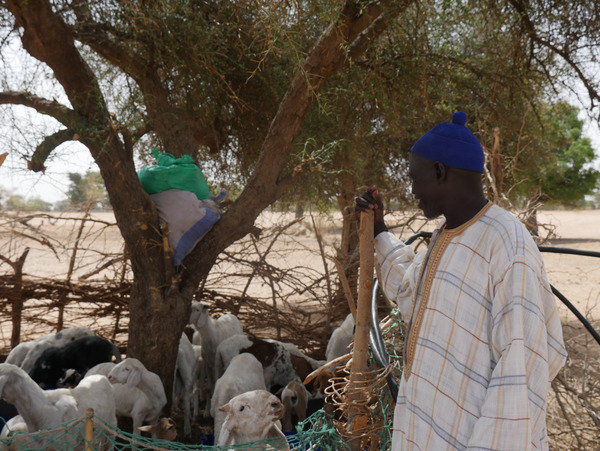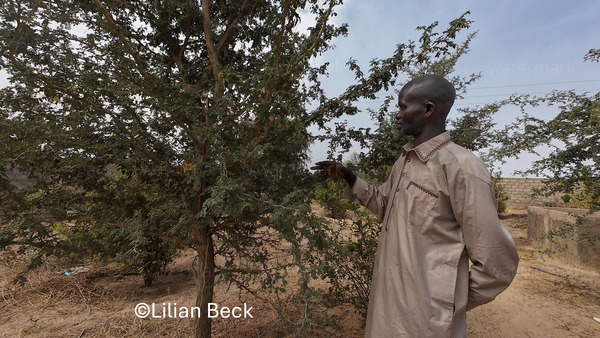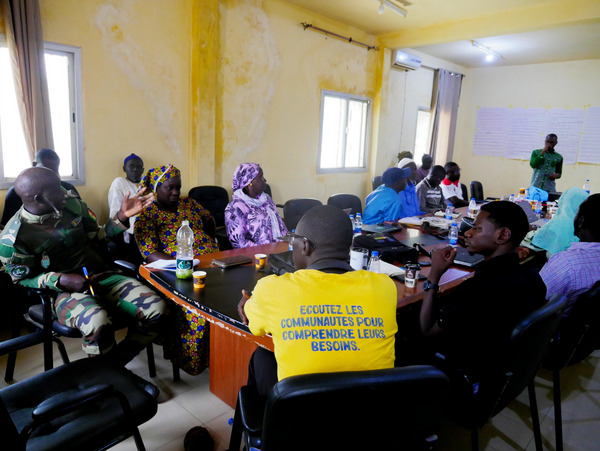Developed through five years of collaboration between producers, researchers, and innovation platforms, the recommendations provide low-cost, agroecological strategies that respond to core challenges facing Sahelian farming systems, including soil degradation and the threat of desertification, declining yields, weed pressure, limited access to livestock feed, and adverse climate change effects.
The recommendations are based on findings from national research institutions, IER and IPR/IFRA (Mali), UNB and INERA (Burkina Faso), CSE (Senegal), ISRA (Senegal), FiBL (Switzerland), U-HOH and Uni Kassel (Germany), in partnership with CIRAD, IRD, and local producer groups.
→ Download: The complete Recommendations to Farmers are available here
→ Final Recommendations to Reasearchers here
→ Final Recommendations to Policy Makers here
For improving crop yields and resilience to climate change effects such as heat, erratic, rain, droughts and flooding
Improve soil fertility by integrating local and shrubs and trees in fields
- Integrate and increase local multipurpose trees and shrubs resilient to local conditions in fields of crops (e.g. millet, sorghum, cotton and groundnuts)
Objective: Encouraging beneficial soil organisms, soil structure, humidity conservation, shading, prevent erosion and storm damage and build organic matter respectively soil fertility.
- Encourage the combined planting of fast-growing and slow-growing species when establishing tree or shrub seedlings
Objective: Promoting early biomass production and sustainable ecosystem services (e.g. enriching soil with organic matter).
- Apply species‑appropriate methods to reduce shade and stimulate growth, such as pruning, coppicing, pollarding, and trimming, to manage shrubs and trees, tailored to both the species and intended outcomes.
Objective: Reduce shading and stimulate robust, healthy growth without harming the plants.
- Pruning, coppicing, pollarding and trimming shrubs and trees and mulching plant residues—appropriately adapted to each shrub or tree species and purpose.
Objective: Manage shade, boost regrowth of fresh leaves by local shrubs and trees without harming them, harvesting biomass for mulching
- Cultivate leguminous shrubs (e.g., Gliricidia, Guiera, Piliostigma, Leucaena) in hedgerows or alleys—pruning them strategically to regulate shade and allow adjacent crops in the corridors to flourish with mulching the pruned plant residues (cut-and-drop mulch)
Objective: Allows for high shrub density per hectare and results in many benefits for crops due to proximity and biomass production of the shrubs.
- Integrate local legume ligneous species such as Faidherbia, Leucaena, Gliricidia
Objective: Nitrogen fixation and soil enrichment.
Additional guides
- youtube.com: Video: An example of an agroforestry farm in the Sahel
- youtube.com: Video - Uncovering secrets of the Miracle Tree Faidherbia albida
- youtube.com: Video - Advantages of agroforestry in the Sahel
- accessagriculture.org: Video - Alley cropping with multi-purpose trees
- zenodo.org: Poster - Improving yields by integrating a diversity of shrubs or trees into crop fields
Increase trees and shrubs
Implement assisted natural regeneration (ANR) by:
- Weeding or slashing competing vegetation to encourage regrowth of existing seedlings.
- Pruning or thinning woody growth selectively to reduce competition and promote healthy sprouting.
- Protecting seedlings from fire and grazing animals, using firebreaks and fences—e.g., barriers crafted from thorny branches.
- Establish rainwater harvesting techniques such as zai pits and stone lines.
Objective: Encourage natural emerging seedling growth of multipurpose local shrubs and trees
- Use on‑farm nurseries to propagate shrub and trees, preferably by seed for species like Leucaena leucocephalaand Faidherbia albida, and by stem cuttings for Gliricidia sepium.
Objective: Enhance the number of trees and shrubs where there is a lack of naturally occurring seedlings.
Additional guides
- accessagriculture.org: Video - Establishing a forest seedling nursery
- youtube.com: Video - Propagation of trees in a Senegalese field
Research findings
→ The grain yield of millet under the canopy of F. albida significantly increases the grain yield of millet compared to outside the tree canopy. This suggests that F. albida has a positive effect on crop productivity. (Senegal) (IRD, CIRAD, ISRA)
→ The proximity of guiera, pruned at the beginning of the season, increases the weight (1000 grains) of millet grains (%). (Senegal) (ISRA)
→ Overall, densities of 1000 and 2000 plants/ha improve carbon and water storage and soil permeability the most.
Mulching of pruning of shrubs and trees
- Avoid burning of residues; instead, use light incorporation or surface composting of woody biomass at the onset of the rainy season.
- Apply prunings from locally available shrubs and trees such as Gliricidia sepium, Piliostigma reticulatum, Guiera senegalensis, Leucaena leucocephala, Parkia biglobosa, and Vitellaria paradoxa as mulch or surface compost before the rainy season and after.
Objective: Protect the soil from erosion, enrich with organic matter and conserve humidity.
- Use mixtures of species with fast and slow decomposition rates for mulch or compost to ensure both rapid and sustained nutrient release.
Additional guides
- accessagriculture.org: Video - Mulching with trees and shrubs
- zenodo.org: Poster - Improved formulations for mulching on site
- zenodo.org: Poster - Farmer mulching of shrub biomass in sorghum plots in the Saria area of Burkina Faso
Research findings
→ IER (Mali) demonstrated that Gliricidia prunings can double sorghum yields. INERA (Burkina Faso) observed similar effects with Vitellaria litter combined with ash.
Use biomass from local shrubs and trees for composting
- Adopt production and use of compost from woody biomass such as Piliostigma reticulatum, Azadirachta indica and Khaya senegalensis to improve crop yields
- Make the best use of a mix of leaves from species with different decomposition rates to ensure complementarity and good productivity of cereal crops.
- Choose species like Neem (Azadirachta indica) for fast nutrient release due to high nitrogen content and low lignin.
- Mix with locally available biomass, e.g. manure and crop residues.
- Adopt the practice of shallow burial of mulch from local shrubs and trees
Additional guide
Research findings
→ Surface composting (light burial of woody biomass) of woody species (Gliricidia sepium, Guiera senegalensis, Leucaena leucocephala, Parkia biglobosa, and Vitellaria paradoxa) improves soil fertility and increases crop yields. (IER, Mali)
Combine soil improvement practices for sustainable soil regeneration
- Apply a combination of mulch, compost, and manure for complementary effects.
Objective: Soil enrichment, efficient nutrient availability, moisture retention and erosion prevention
Apply manure from livestock on the field for instance by grazing livestock in rotating locations during dry season or composting manure combined with local tree/shrub/crop residues to apply on the fields. If organic amendments are lacking, prioritise degraded or crusted field areas to restore soil life and structure effectively. Reduce mineral fertiliser with surface composting to avoid soil degradation.
- Prioritize organic matter inputs and use mineral fertilizers only in reduced doses and in combination with organic soil amendments such as mulch, compost and manure, to lower costs, regenerate soil fertility and health, and improve nutrient use efficiency. Combine tree and shrub planting with zaï pits, stone bunds, and mulching to improve soil structure and water retention.
- In shallow soils, plant Piliostigma or Guiera at densities of 1,000–2,000 plants/ha to improve permeability and reduce erosion.
- Apply lime on acidic soils to raise pH and improve maize yields.
Conserve soil moisture
- Encourage tree and shrub growth. Apply the soil improvement strategies above to improve soil structure for water retention.
- Combine tree and shrub planting with zaï pits, stone bunds, and mulching to water retention and infiltrationDensities of 1,000 to 2,000 trees per hectare of P. reticulatum are recommended to improve permeability and water storage capacity.
Additional guide
- zenodo.org: Poster - Improving yields by integrating a diversity of shrubs or trees into crop fields
Research findings
→ Faidherbia albida and Guiera improve subsoil moisture availability via hydraulic lift (CIRAD, IRD).
→ The presence of shea trees (Vitellaria paradoxa) on farms improves soil moisture content and contributes to higher crop yields (cotton, maize) in the Sudanese zone of southern Mali. (IER)
→ Densities of 1,000 to 2,000 trees per hectare of P. reticulatum improved permeability and water storage capacity. (UNB)
Reduce weed and Striga pressure
- Integrate trees like Faidherbia albida, Piliostigma, and Guiera into cereal fields to suppress Striga hermonthica and improve crop growth.
- Use surface composting and mulch of woody biomass to control weeds such as Cyperus rotundus.
Research findings
→ Surface composting with woody prunings inhibits weed emergence by 58% compared to the control without fertilizer and increases sorghum yield. (IPR, Mali)
→ The proximity of Faidherbia albida significantly reduces (53%) striga infestation in plots compared to those located outside the tree canopy. (ISRA) (Senegal)
→ There is less infestation of Striga hermontica near Guiera species. (ISRA) (Senegal)
Improve livestock feeding with local fodder resources
- Feeding sheep with the pods of Acacia raddiana and Piliostigma reticulatum, as well as the leaves of Balanites aegyptiaca, Ficus sycomorus, Khaya senegalensis, Pterocarpus lucens, and Pterocarpus santallinoides improves sheep weight gain when incorporated at a level of 30% (dry matter) in the daily ration.
- Use the OPÉRAS tool to balance rations and optimise feed efficiency.
Research findings
→ Sheep fed with 30% (dry matter) of Ficus sycomorus leaves, Khaya senegalensis leaves, or Piliostigma reticulatum pods in their daily ration show weight gains similar to those obtained with peanut husk supplementation. Good results have also been obtained with Pterocarpus erinaceus leaves, although their use remains limited due to the species' "endangered" status according to the IUCN. (INERA)
Improve livestock health
- Supplement small ruminants (goats and sheeps) daily diets with 40% fresh leaves from Adansonia digitata, Ziziphus mauritiana, Khaya senegalensis, or Balanites aegyptiaca for 14 days to reduce parasite loads
- Use FAMACHA© scoring to detect parasite-related anaemia and target deworming treatments effectively and observe small ruminants for intestinal nematodes especially during rainy season (period of heavy infestation)
Additional guides
- accessagriculture.org: Video - Managing intestinal nematodes in small ruminants
- zenodo.org: Poster - Application of medicinal trees and shrubs to treat gastrointestinal nematode infestations
Research findings
→ The incorporation of 40% or more of fresh leaves from Adansonia digitata, Ziziphus mauritiana, Khaya senegalensis or Balanites aegyptiaca over a period of 14 days in the sheep and goats daily rations substantially reduces intestinal nematodes infestation during the rainy season.
→ During the rainy season, feeding fresh Khaya senegalensis leaves (at a rate of 40% of the ration for 14 days) helps to effectively combat GIP, with a 42% reduction in eggs in feces observed after 7 days of feeding. (INERA)
→ Fresh Khaya senegalensis leaves are particularly effective in reducing the number of GIP eggs in sheep feces when incorporated into feed rations at a rate of 40% for 14 days during the rainy season. (IPR)
Restore pastures and biodiversity
- Increase tree and shrub presence in pastures to promote herbaceous growth and ecosystem restoration.
- Encourage fallowing and fencing under key species such as Balanites aegyptiaca.
- Establish local grazing agreements to protect regenerating areas and reduce pressure on restored rangelands.
Research findings
→ ISRA (Senegal) recorded a 283% increase in herbaceous biomass under fallowed Balanites trees.
Strengthen local capacity and support structures
- Maintain and expand Innovation Platforms for joint experimentation and knowledge exchange.
- Organise quarterly meetings of multi-actor platforms and regular exchanges between producer members.
- Train nursery operators on propagation methods, species selection, and agroforestry management.
- Equip extension services to support producers in understanding:
- Benefits of agroforestry practices in the Sahel
- Optimal species densities
- Cost-benefit analyses of new practices
- Environmental trade-offs
- Carefully evaluate any introduced species to avoid ecological risks such as invasiveness.
These recommendations are being disseminated through visual posters, videos, local-language training materials, and farmer-led demonstrations, with the support of innovation platforms and extension services. They aim to support producers in adopting technically and economically viable agroecological practices adapted to Sahelian conditions, contributing to the restoration of soil fertility, the intensification of production systems, and the strengthening of resilience to climate variability.
For more detailed information you can soon find the chapter on agroforestry practices in the Sahel here:
organic-africa.net






 tap and then scroll down to the Add to Home Screen command.
tap and then scroll down to the Add to Home Screen command.